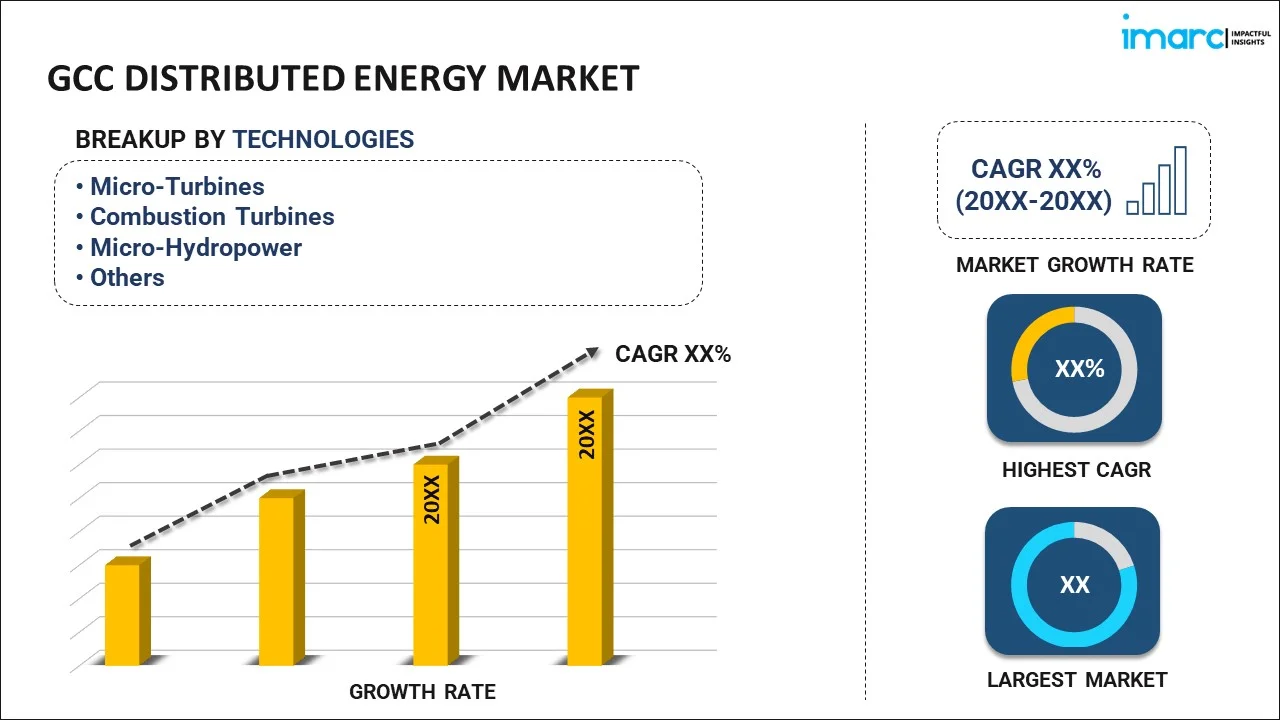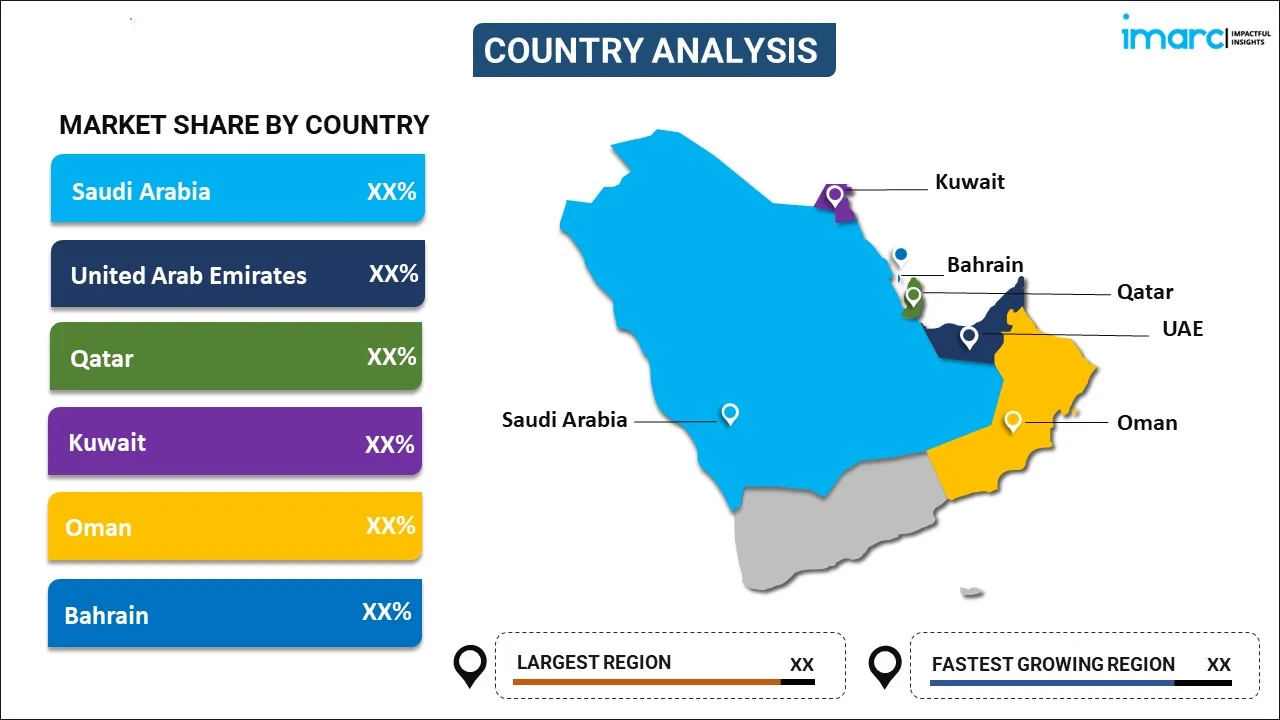
GCC Distributed Energy Market Report by Technology (Micro-Turbines, Combustion Turbines, Micro-Hydropower, Reciprocating Engines, Fuel Cells, Wind Turbines, Solar PV), End Use Industry (Residential, Commercial, Industrial), and Country 2024-2032
Market Overview:
The GCC distributed energy market size is projected to exhibit a growth rate (CAGR) of 22.9% during 2024-2032. The emerging technological advancements in renewable energy technologies, the implementation of favorable policies to encourage the adoption of distributed energy systems, and the rising energy demand due to the growing population represent some of the key factors driving the market.
|
Report Attribute
|
Key Statistics
|
|---|---|
|
Base Year
|
2023
|
|
Forecast Years
|
2024-2032
|
|
Historical Years
|
2018-2023
|
| Market Growth Rate (2024-2032) | 22.9% |
Distributed energy refers to the decentralized generation and distribution of electricity. It involves small-scale power generation units situated close to the point of consumption, reducing transmission losses and enhancing grid resilience. These systems often utilize renewable energy sources such as solar panels, wind turbines, and combined heat and power (CHP) technologies. It offers several benefits, such as enhancing energy efficiency by capturing waste heat and minimizing greenhouse gas (GHG) emissions, aligning with global efforts to combat climate change. Additionally, distributed energy systems provide localized power supply, enhancing energy security and reducing vulnerability to disruptions. Moreover, governments and businesses in the GCC are investing in distributed energy projects to promote sustainability and drive economic growth. Nowadays, distributed energy is gaining immense traction with abundant sunlight and wind resources from solar and wind power projects that ensure a resilient and cleaner energy future while positioning themselves as pioneers in the transition to a sustainable energy market across the GCC region.
GCC Distributed Energy Market Trends:
The market is primarily driven by the increasing energy demand among individuals. In addition, rapid urbanization and the growing population led to rising energy consumption, thus contributing to market growth. Additionally, distributed energy solutions offer a scalable approach to meeting this growing demand, allowing for incremental capacity additions tailored to specific local requirements. Moreover, several technological advancements in renewable energy technologies significantly minimize the costs associated with distributed energy installations, representing another major growth-inducing factor. Along with this, the declining costs of solar panels, wind turbines, and energy storage systems make distributed energy solutions increasingly affordable and accessible to various consumers, thus augmenting market growth. Besides this, the growing concerns about energy security are encouraging GCC nations to explore alternative sources of power with distributed energy systems, such as solar panels on rooftops and small-scale wind turbines, to enhance energy resilience by diversifying the energy mix and reducing reliance on centralized power grids, thus accelerating the market growth. In line with this, the growing environmental awareness led to the widespread adoption of distributed energy systems, particularly those utilizing renewable sources, including solar and wind, to lower carbon footprint and combat climate change, thus influencing the market growth. Apart from this, the implementation of several favorable initiatives, incentives, and subsidies to encourage the adoption of distributed energy systems, including feed-in tariffs, net metering programs, and regulatory frameworks that support private sector participation in the renewable energy sector, are propelling market growth. Furthermore, the GCC nations are investing in developing their infrastructure and incorporating distributed energy solutions to integrate into new developments and retrofit projects, creating a positive market outlook.
GCC Distributed Energy Market Segmentation:
IMARC Group provides an analysis of the key trends in each segment of the GCC distributed energy market report, along with forecasts at the regional and country levels for 2024-2032. Our report has categorized the market based on technology and end use industry.
Technology Insights:

- Micro-Turbines
- Combustion Turbines
- Micro-Hydropower
- Reciprocating Engines
- Fuel Cells
- Wind Turbines
- Solar PV
The report has provided a detailed breakup and analysis of the market based on technology. This includes micro-turbines, combustion turbines, micro-hydropower, reciprocating engines, fuel cells, wind turbines, and solar PV.
End Use Industry Insights:
- Residential
- Commercial
- Industrial
A detailed breakup and analysis of the market based on the end use industry has also been provided in the report. This includes residential, commercial, and industrial.
Country Insights:

- Saudi Arabia
- UAE
- Qatar
- Bahrain
- Kuwait
- Oman
The report has also provided a comprehensive analysis of all the major regional markets, which include Saudi Arabia, the UAE, Qatar, Bahrain, Kuwait, and Oman.
Competitive Landscape:
The report has also provided a comprehensive analysis of the competitive landscape in the market. Competitive analysis such as market structure, key player positioning, top winning strategies, competitive dashboard, and company evaluation quadrant has been covered in the report. Also, detailed profiles of all major companies have been provided.
GCC Distributed Energy Market Report Coverage:
| Report Features | Details |
|---|---|
| Base Year of the Analysis | 2023 |
| Historical Period | 2018-2023 |
| Forecast Period | 2024-2032 |
| Units | US$ Million |
| Scope of the Report | Exploration of Historical and Forecast Trends, Industry Catalysts and Challenges, Segment-Wise Historical and Predictive Market Assessment:
|
| Technologies Covered | Micro-Turbines, Combustion Turbines, Micro-Hydropower, Reciprocating Engines, Fuel Cells, Wind Turbines, Solar PV |
| End Use Industries Covered | Residential, Commercial, Industrial |
| Countries Covered | Saudi Arabia, UAE, Qatar, Bahrain, Kuwait, Oman |
| Customization Scope | 10% Free Customization |
| Report Price and Purchase Option | Single User License: US$ 2899 Five User License: US$ 4899 Corporate License: US$ 7899 |
| Post-Sale Analyst Support | 10-12 Weeks |
| Delivery Format | PDF and Excel through Email (We can also provide the editable version of the report in PPT/Word format on special request) |
Key Questions Answered in This Report:
- How has the GCC distributed energy market performed so far and how will it perform in the coming years?
- What has been the impact of COVID-19 on the GCC distributed energy market?
- What is the breakup of the GCC distributed energy market on the basis of technology?
- What is the breakup of the GCC distributed energy market on the basis of end use industry?
- What are the various stages in the value chain of the GCC distributed energy market?
- What are the key driving factors and challenges in the GCC distributed energy market?
- What is the structure of the GCC distributed energy market and who are the key players?
- What is the degree of competition in the GCC distributed energy market?
Key Benefits for Stakeholders:
- IMARC’s report offers a comprehensive quantitative analysis of various market segments, historical and current market trends, market forecasts, and dynamics of the GCC distributed energy market from 2018-2032.
- The research study provides the latest information on the market drivers, challenges, and opportunities in the GCC distributed energy market.
- Porter's five forces analysis assist stakeholders in assessing the impact of new entrants, competitive rivalry, supplier power, buyer power, and the threat of substitution. It helps stakeholders to analyze the level of competition within the GCC distributed energy industry and its attractiveness.
- Competitive landscape allows stakeholders to understand their competitive environment and provides an insight into the current positions of key players in the market.
Need more help?
- Speak to our experienced analysts for insights on the current market scenarios.
- Include additional segments and countries to customize the report as per your requirement.
- Gain an unparalleled competitive advantage in your domain by understanding how to utilize the report and positively impacting your operations and revenue.
- For further assistance, please connect with our analysts.
 Inquire Before Buying
Inquire Before Buying
 Speak to an Analyst
Speak to an Analyst
 Request Brochure
Request Brochure
 Request Customization
Request Customization




.webp)




.webp)












